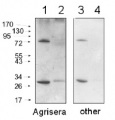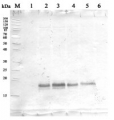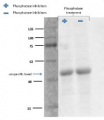1
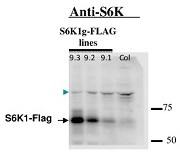
Anti-S6K1/2 | Ribosomal S6 kinase 1/2
AS12 1855 | Clonality: Polyclonal | Host: Rabbit | Reactivity: Arabidopsis thaliana
- Product Info
-
Immunogen: KLH-conjugated peptide, derived from Arabidopsis thaliana S6K1: UniProt: P42818, TAIR: AT3G08730 and S6K2: UniProt: Q39030, TAIR: AT3G08720. Due to high amino acid homology, chosen peptide is conserved in both proteins: S6K1 and S6K2. Host: Rabbit Clonality: Polyclonal Purity: Immunogen affinity purified serum in PBS pH 7.4. Contains 0.02% sodium azide. Format: Lyophilized Quantity: 50 µg Storage: Store lyophilized/reconstituted at -20°C; once reconstituted make aliquots to avoid repeated freeze-thaw cycles,Please remember to spin the tubes briefly prior to opening them to avoid any losses that might occur from material adhering to the cap or sides of the tube. Tested applications: Western blot (WB) Recommended dilution: 1 : 750-1 : 1000 (WB) Expected | apparent MW: 52.6 kDa (S6K1) and 53 kDa (S6K2) - Reactivity
-
Confirmed reactivity: Arabidopsis thaliana Predicted reactivity: Brassica oleracea, Hordeum vulgare, Oryza sativa, Physcomitrella patens, Thelungiella halophila, Triticum aestivum, Zea mays
Species of your interest not listed? Contact usNot reactive in: Setaria viridis, Solanum lycopersicum, Solanum tuberosum, Vitis vinifera
- Application Examples
-
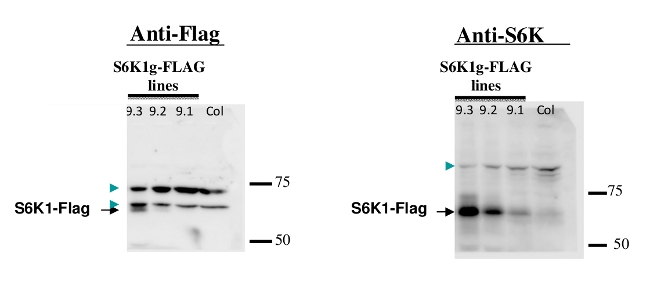
20 µg of total protein from flowers and leaves of transgenic Arabidopsis thaliana lines were analysed (expressing the genomic copy of S6K1 tagged with FLAG epitop under the control of its own promoter) extracted with homogenization buffer were separated on 10% SDS-PAGE and blotted 2h to PVDF. Blots were blocked with 5% milk in TBST for 1h at room temperature (RT) with agitation. Blot was incubated in the primary antibody at a dilution of 1:750 for overnight at 4C with agitation. The antibody solution was decanted and the blot was washed three times for 15 min in TBS-T at RT with agitation. Blot was incubated in secondary antibody (anti-rabbit IgG horse radish peroxidase conjugated from Agrisera, AS09 602) diluted to 1:10 000 in 2.5% milk in TBST for 1h at RT with agitation. The blot was washed as above and developed for 5 min with ECL according to the manufacturer's instructions. Exposure time was few minutes.
Courtesy of Dr. Rossana Henriques, CRAG, Spain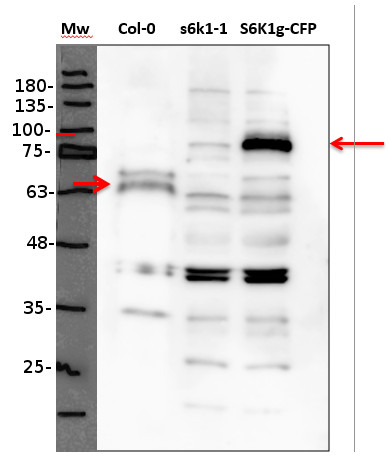
20 µg of total protein from Arabidopsis thaliana total wilde type (Col-0), deletion mutant (s6k1-1), overexpression mutant (S6K1g-CFP) extracted with homogenization buffer were separated on 10% SDS-PAGE and blotted 2h to PVDF. Blots were blocked with 5% milk in TBST for 1h at room temperature (RT) with agitation. Blot was incubated in the primary antibody at a dilution of 1:1000 for overnight at 4C with agitation. The antibody solution was decanted and the blot was washed three times for 15 min in TBS-T at RT with agitation. Blot was incubated in secondary antibody (anti-rabbit IgG horse radish peroxidase conjugated from Agrisera, AS09 602) diluted to 1:10 000 in 2.5% milk in TBST for 1h at RT with agitation. The blot was washed as above and developed for 5 min with ECL according to the manufacturer's instructions. Exposure time was few minutes.
Courtesy of Dr. Rossana Henriques, CRAG, SpainApplication examples: 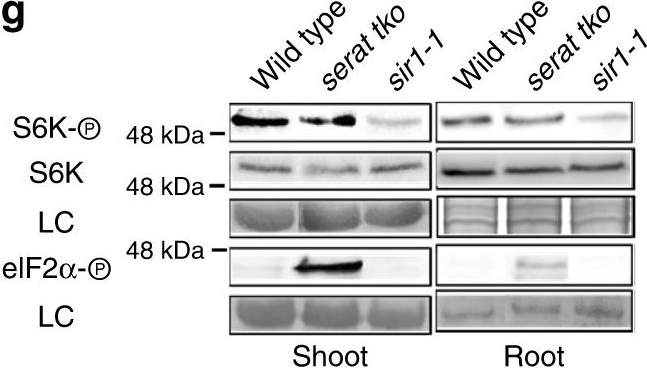
Reactant: Arabidopsis thaliana (Thale cress)
Application: Western Blotting
Pudmed ID: 29079776
Journal: Nat Commun
Figure Number: 2G
Published Date: 2017-10-27
First Author: Dong, Y., Silbermann, M., et al.
Impact Factor: 13.783
Open PublicationSpecific sensing of C/N- or S-precursors for Cys results in distinct transcriptome reprogramming and specific translation regulation. a Venn diagrams and b–e functional category analysis (p?
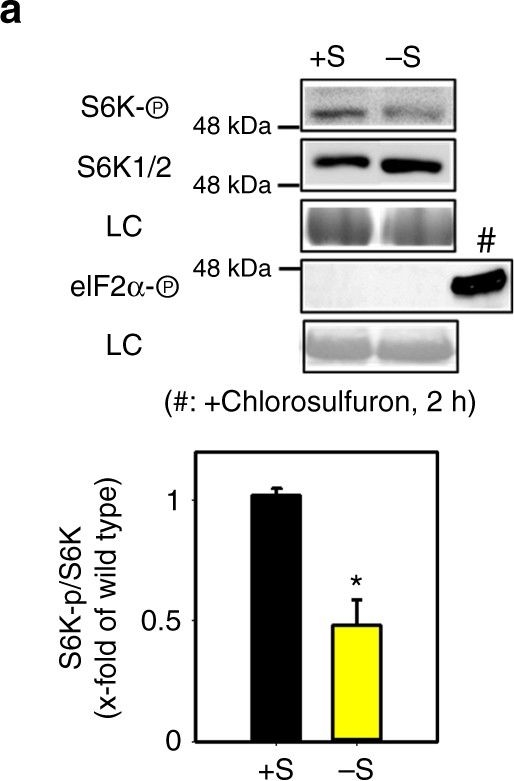
Reactant: Arabidopsis thaliana (Thale cress)
Application: Western Blotting
Pudmed ID: 29079776
Journal: Nat Commun
Figure Number: 3A
Published Date: 2017-10-27
First Author: Dong, Y., Silbermann, M., et al.
Impact Factor: 13.783
Open PublicationSulfur availability downregulates TOR activity and sugar metabolism. a Immunological detection of S6K-p, S6K (52?kDa) and eIF2?-p (43?kDa) with specific antisera was used for calculation of relative TOR activity by the ratio of S6K-p/S6K in x-fold of wild type (n?=?3, mean?±?s.e.m., t-test, *p?

Reactant: Arabidopsis thaliana (Thale cress)
Application: Western Blotting
Pudmed ID: 29079776
Journal: Nat Commun
Figure Number: 3D
Published Date: 2017-10-27
First Author: Dong, Y., Silbermann, M., et al.
Impact Factor: 13.783
Open PublicationSulfur availability downregulates TOR activity and sugar metabolism. a Immunological detection of S6K-p, S6K (52?kDa) and eIF2?-p (43?kDa) with specific antisera was used for calculation of relative TOR activity by the ratio of S6K-p/S6K in x-fold of wild type (n?=?3, mean?±?s.e.m., t-test, *p?
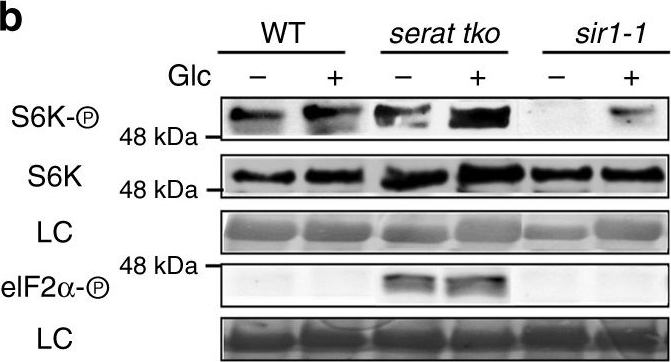
Reactant: Arabidopsis thaliana (Thale cress)
Application: Western Blotting
Pudmed ID: 29079776
Journal: Nat Commun
Figure Number: 4B
Published Date: 2017-10-27
First Author: Dong, Y., Silbermann, M., et al.
Impact Factor: 13.783
Open PublicationSulfur availability regulates root meristem and plant growth via glucose-TOR. a Phenotype of chimeric plants obtained by grafting of wild-type (WT) and sir1-1 organs. Identity of organs is depicted as shoot/root. Scale bar, 2?cm. b–e Feeding of serat tko and sir1-1 seedlings with glucose. b Immunological detection of S6K-p, S6K (apparent sizes: 52?kDa), and eIF2?-p (apparent size: 43?kDa) with specific antisera in wild-type serat tko and sir1-1. c, d Phenotype of wild-type serat tko and sir1-1 plants in the absence and presence of glucose. Scale bar, 1?cm. e Impact of glucose on root meristem activity in wild-type serat tko and sir1-1. Scale bar, 25?µm. f Root meristem activity of 7-day-old WT seedlings treated with TOR inhibitor (AZD-8055) or GCN2 activator (Chlorosulfuron, CHL) for 2?h. Scale bar, 25?µm
- Additional Information
-
Additional information: So far in applied conditions and extracts endogenous S6K1/2 protein is detectable as a very weak band Additional information (application): Keeping the samples at 4°C all times is of crucial importance. Laucs buffer was used in example below since this is the one which was used routinely by this test laboratory for the work with kinases. Some unspecific bands can be seen, depending upon western blot protocol which is used. Therefore please consider to use a negative control together with your samples - Background
-
Background: Ribosomal S6 kinase 1/2 (S6K1/2) involved in TOR signaling pathway, in osmotic stress response. Activated by PDK1 and repressed during osmotic stress. Expressed in all tissues, especially during high metabolic activity in growing buds, root tips, leaf margins and germinating seeds. Alternative names: AtPK1/AtPK6 S6K1), AtPK2/AtPK19 (S6K2).
- Product Citations
-
Selected references: O'Leary et al. (2025).T arget of rapamycin signaling in pea embryos is dependent on glutamine but detached from seed storage protein biosynthesis. New Phytol. 2025 Oct 15.doi: 10.1111/nph.70622.
Tanigawa et al. (2024). FYVE1/FREE1 is involved in glutamine-responsive TORC1 activation in plants. iScience. 2024 Aug 26;27(9):110814. doi: 10.1016/j.isci.2024.110814.
Linster et al. (2022). Cotranslational N-degron masking by acetylation promotes proteome stability in plants. Nat Commun. 2022 Feb 10;13(1):810. doi: 10.1038/s41467-022-28414-5. PMID: 35145090; PMCID: PMC8831508.
Jamsheer et al. (2022) A negative feedback loop of TOR signaling balances growth and stress-response trade-offs in plants. Cell Rep. 2022 Apr 5;39(1):110631. doi: 10.1016/j.celrep.2022.110631. PMID: 35385724.
Wang et al. (2022), FERONIA functions through Target of Rapamycin (TOR) to negatively regulate autophagy, Front. Plant Sci., 23 August 2022, Sec. Plant Cell Biology, Volume 13 - 2022, https://doi.org/10.3389/fpls.2022.961096.
González-López et al. (2021). Growth promotion in Arabidopsis thaliana by bacterial cyclodipeptides involves the TOR/S6K pathway activation. Journal of Plant Physiology. Volume 257, 2021, 153343,ISSN 0176-1617, https://doi.org/10.1016/j.jplph.2020.153343.
Salazar-Diaz et al. (2021) TOR senses and regulates spermidine metabolism during seedling establishment and growth in maize and Arabidopsis. iScience. 2021 Oct 12;24(11):103260. doi: 10.1016/j.isci.2021.103260. PMID: 34765910; PMCID: PMC8571727.
Angelos & Brandizzi (2021). The UPR regulator IRE1 promotes balanced organ development by restricting TOR-dependent control of cellular differentiation in Arabidopsis. Plant J. 2021 Dec 11. doi: 10.1111/tpj.15629. Epub ahead of print. PMID: 34902186.
Kazibwe et al. (2020). TOR mediates the autophagy response to altered nucleotide homeostasis in a ribonuclease mutant. J Exp Bot. 2020 Sep 9;eraa410.doi: 10.1093/jxb/eraa410.
Dong et al. (2019). The Arabidopsis THADA homologue modulates TOR activity and cold acclimation. Plant Biol (Stuttg). 2019 Jan;21 Suppl 1:77-83. doi: 10.1111/plb.12893.
Inaba and Nagy (2018). Tombusvirus RNA replication depends on the TOR pathway in yeast and plants. Virology. 2018 Jun;519:207-222. doi: 10.1016/j.virol.2018.04.010.
Pfeiffer et al. (2016). Integration of light and metabolic signals for stem cell activation at the shoot apical meristem. Elife. 2016 Jul 11;5. pii: e17023. doi: 10.7554/eLife.17023. - Protocols
-
Agrisera Western Blot protocol and video tutorials
Protocols to work with plant and algal protein extracts
Oxygenic photosynthesis poster by prof. Govindjee and Dr. Shevela
Z-scheme of photosynthetic electron transport by prof. Govindjee and Dr. Björn and Dr. Shevela - Reviews:
-
This product doesn't have any reviews.

